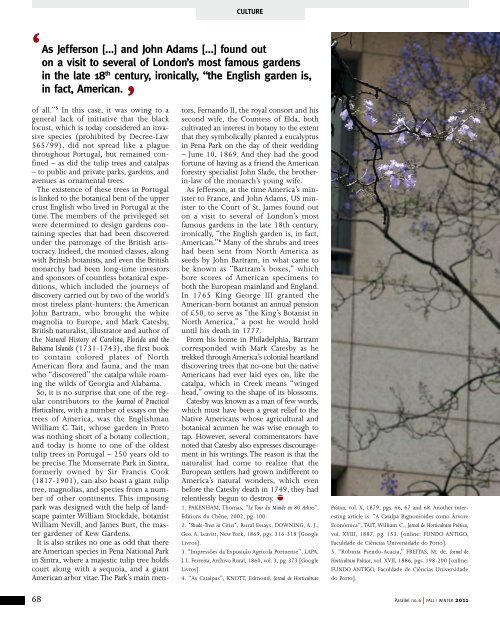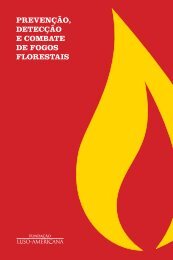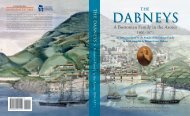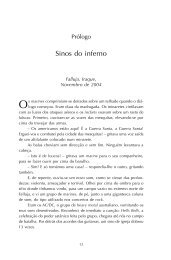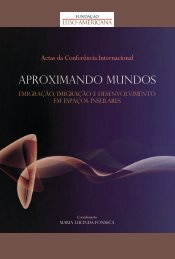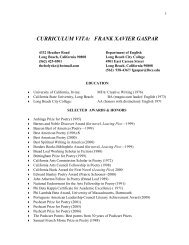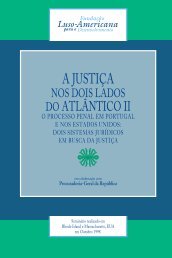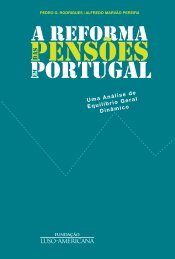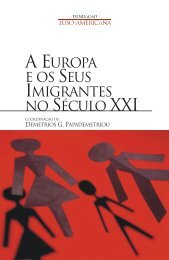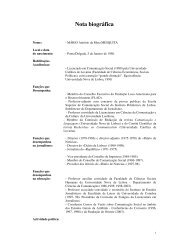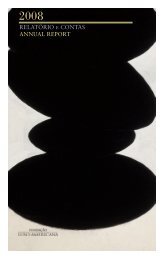A decade later - Fundação Luso-Americana
A decade later - Fundação Luso-Americana
A decade later - Fundação Luso-Americana
Create successful ePaper yourself
Turn your PDF publications into a flip-book with our unique Google optimized e-Paper software.
68<br />
cuLTure<br />
‘ As Jefferson […] and John Adams […] found out<br />
on a visit to several of London’s most famous gardens<br />
in the late 18 th century, ironically, “the english garden is,<br />
in fact, American.<br />
’<br />
of all.” 5 In this case, it was owing to a<br />
general lack of initiative that the black<br />
locust, which is today considered an invasive<br />
species (prohibited by Decree-Law<br />
565/99), did not spread like a plague<br />
throughout Portugal, but remained confined<br />
– as did the tulip trees and catalpas<br />
– to public and private parks, gardens, and<br />
avenues as ornamental trees.<br />
The existence of these trees in Portugal<br />
is linked to the botanical bent of the upper<br />
crust English who lived in Portugal at the<br />
time. The members of the privileged set<br />
were determined to design gardens containing<br />
species that had been discovered<br />
under the patronage of the British aristocracy.<br />
Indeed, the monied classes, along<br />
with British botanists, and even the British<br />
monarchy had been long-time investors<br />
and sponsors of countless botanical expeditions,<br />
which included the journeys of<br />
discovery carried out by two of the world’s<br />
most tireless plant-hunters: the American<br />
John Bartram, who brought the white<br />
magnolia to Europe, and Mark Catesby,<br />
British naturalist, illustrator and author of<br />
the Natural History of Carolina, Florida and the<br />
Bahama Islands (1731-1743), the first book<br />
to contain colored plates of North<br />
American flora and fauna, and the man<br />
who “discovered” the catalpa while roaming<br />
the wilds of Georgia and Alabama.<br />
So, it is no surprise that one of the regular<br />
contributors to the Journal of Practical<br />
Horticulture, with a number of essays on the<br />
trees of America, was the Englishman<br />
William C. Tait, whose garden in Porto<br />
was nothing short of a botany collection,<br />
and today is home to one of the oldest<br />
tulip trees in Portugal – 250 years old to<br />
be precise. The Monserrate Park in Sintra,<br />
formerly owned by Sir Francis Cook<br />
(1817-1901), can also boast a giant tulip<br />
tree, magnolias, and species from a number<br />
of other continents. This imposing<br />
park was designed with the help of landscape<br />
painter William Stockdale, botanist<br />
William Nevill, and James Burt, the master<br />
gardener of Kew Gardens.<br />
It is also strikes no one as odd that there<br />
are American species in Pena National Park<br />
in Sintra, where a majestic tulip tree holds<br />
court along with a sequoia, and a giant<br />
American arbor vitae. The Park’s main men-<br />
tors, Fernando II, the royal consort and his<br />
second wife, the Countess of Elda, both<br />
cultivated an interest in botany to the extent<br />
that they symbolically planted a eucalyptus<br />
in Pena Park on the day of their wedding<br />
– June 10, 1869. And they had the good<br />
fortune of having as a friend the American<br />
forestry specialist John Slade, the brotherin-law<br />
of the monarch’s young wife.<br />
As Jefferson, at the time America’s minister<br />
to France, and John Adams, US minister<br />
to the Court of St. James found out<br />
on a visit to several of London’s most<br />
famous gardens in the late 18th century,<br />
ironically, “the English garden is, in fact,<br />
American.” 6 Many of the shrubs and trees<br />
had been sent from North America as<br />
seeds by John Bartram, in what came to<br />
be known as “Bartram’s boxes,” which<br />
bore scores of American specimens to<br />
both the European mainland and England.<br />
In 1765 King George III granted the<br />
American-born botanist an annual pension<br />
of £50, to serve as “the King’s Botanist in<br />
North America,” a post he would hold<br />
until his death in 1777.<br />
From his home in Philadelphia, Bartram<br />
corresponded with Mark Catesby as he<br />
trekked through America’s colonial heartland<br />
discovering trees that no-one but the native<br />
Americans had ever laid eyes on, like the<br />
catalpa, which in Creek means “winged<br />
head,” owing to the shape of its blossoms.<br />
Catesby was known as a man of few words,<br />
which must have been a great relief to the<br />
Native Americans whose agricultural and<br />
botanical acumen he was wise enough to<br />
tap. However, several commentators have<br />
noted that Catesby also expresses discouragement<br />
in his writings. The reason is that the<br />
naturalist had come to realize that the<br />
European settlers had grown indifferent to<br />
America’s natural wonders, which even<br />
before the Catesby death in 1749, they had<br />
relentlessly begun to destroy.<br />
1. PAKENHAM, Thomas, “Le Tour du Monde en 80 Arbres”,<br />
Éditions du Chêne, 2002, pg. 100.<br />
2. “Shade-Trees in Cities”, Rural Essays, DOWNING, A. J.,<br />
Geo. A. Leavitt, New York, 1869, pgs. 316-318 [Google<br />
Livros].<br />
3. “Impressões da Exposição Agrícola Portuense”, LAPA,<br />
J. L. Ferreira, Archivo Rural, 1860, vol. 3, pg. 373 [Google<br />
Livros].<br />
4. “As Catalpas”, KNOTT, Edmond, Jornal de Horticultura<br />
Prática, vol. X, 1879, pgs. 66, 67 and 68. Another interesting<br />
article is: “A Catalpa Bignonioides como Árvore<br />
Económica”, TAIT, William C., Jornal de Horticultura Prática,<br />
vol. XVIII, 1887, pg. 153. [online: FUNDO ANTIGO,<br />
Faculdade de Ciências Universidade do Porto].<br />
5. “Robinia Pseudo-Acacia,” FREITAS, M. de, Jornal de<br />
Horticultura Prática, vol. XVII, 1886, pgs. 198-200 [online:<br />
FUNDO ANTIGO, Faculdade de Ciências Universidade<br />
do Porto].<br />
Parallel no. 6 | FALL | WINTER 2011


